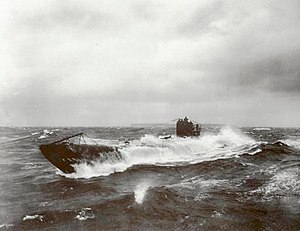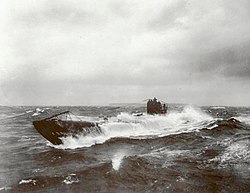SM UB 110
| SM UB 110 (vorheriges/nächstes – alle U-Boote) | |
|---|---|
 Boot derselben Baureihe: SM UB 148 | |
| Typ: | UB III |
| Werft: | Blohm & Voss |
| Kommandanten: | |
| Einsätze: | |
| Versenkungen: | |
| Verbleib: | Am 18. Juli 1918 versenkt. Verschrottet. |
SM UB 110 war ein deutsches U-Boot der Klasse UB III, das im Ersten Weltkrieg eingesetzt wurde. Einziger Kommandant war Kapitänleutnant Werner Fürbringer. Es wurde am 18. Juli 1918 vom Zerstörer HMS Garry vor der Ostküste Englands gerammt und versenkt.[1]
Die Besatzung konnte sich zunächst bis auf die beiden Funker aus dem sinkenden U-Boot retten. Währenddessen wurde das sinkende Wrack weiter von dem Zerstörer sowie den Geleitschiffen ML 49 und ML 263 beschossen. Anschließend beschossen die Fahrzeuge die im Wasser treibenden Überlebenden,[2] sodass nur 13 der 34 Besatzungsmitglieder überlebten.
Das Boot wurde gehoben und später verschrottet. Fotoaufnahmen des Boots wurden 2016 veröffentlicht.[3]
Literatur
- Paul Kemp, Lothar Buchheim: Die deutschen und österreichischen U-Boot-Verluste in beiden Weltkriegen. Urbes, Gräfelfing vor München 1998, ISBN 3-924896-43-7.
- Harald Bendert: Die UB-Boote der Kaiserlichen Marine, 1914–1918. Einsätze, Erfolge, Schicksal. Verlag E.S. Mittler & Sohn GmbH, Hamburg 2000, ISBN 3-8132-0713-7.
- Werner Fürbringer: Alarm! Tauchen! U-Boot in Kampf und Sturm. Deutscher Verlag, 1933
Einzelnachweise
- ↑ U-Boot im Ersten Weltkrieg – Kalt wie in einem Eiskeller In: SpiegelOnline. Abgerufen am 2. Mai 2016
- ↑ Harald Bendert: Die UB-Boote der Kaiserlichen Marine 1914–1918. S. 179
- ↑ The century-old images of a German WWI U-Boat raised from depths of the North Sea – Daily Mail Online
Auf dieser Seite verwendete Medien
War Ensign of the en:German Empire from 1903-1919 (correction of date shown on image which shows 1918). Based on image of coat of arms at [1]. Currently unable to add further details for crown or further details to sceptor due to lack of high-quality images of the coat of arms.
The former German submarine UB 148 at sea, after having been surrendered to the United States.
U.S. Navy History: "UB-148—a UB.III series, small, coastal submarine— was laid down during the winter of 1917 and 1918 at Bremen, Germany, by Aktiengesellschaft Weser; launched on 7 August 1918; but never commissioned in the Imperial German Navy. She was completing preparations for commissioning when the armistice of 11 November ended hostilities. Two days later, she was interned at the Swedish naval base located at Karls-krona, Sweden, to await her fate. By the terms of the armistice, Germany was required to destroy her aircraft and submarines or surrender them to the Allies. On 26 November, UB-148 was surrendered to the British at Harwich, England. Later, when the United States Navy expressed an interest in acquiring several former U-boats, to use in conjunction with a Victory Bond drive, UB-148 was one of the six boats allocated for that purpose. Her American crew, sent to England early in March 1919, took her over later that month, began preparing her for the voyage to America, and placed her in commission, Lt. Comdr. Harold T. Smith in command. The U-boat departed England on 3 April 1919 in company with Bushnell (Submarine Tender No. 2) and three other submarines—U-117, UB-88, and UC-97. That task organization, the Ex-German Submarine Expeditionary Force, steamed via the Azores and Bermuda to New York, where it arrived on 27 April. After a period of repairs, the submarines were opened for visits by the public. Tourists, reporters and photographers joined Navy technicians and civilian shipbuilders in swarming over UB-148 and the other submarines. Following that, UB-148 received instructions to call at ports along the east coast of the United States in the immediate vicinity of New York City in conjunction with the bond drive. At the conclusion of the drive that summer, she and U-lll were subjected to extensive tests and trials to evaluate their performance capability. When that experimentation ended, she joined U-117 and U-140 at the Philadelphia Navy Yard, where they were laid up pending final disposition. She was dismantled at Philadelphia; and, during the summer of 1921, her hulk was used in gunnery and aerial bombing tests conducted off the east coast. Following those tests, UB-148 was sunk by gunfire from Sicard (DD-346)." [1]

